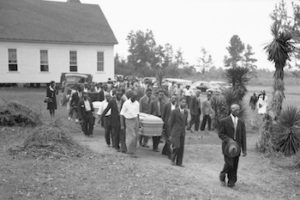Death is inevitable. Mortals die through natural and unnatural deaths. In times of death, rites are observed for the departed all over the world for different reasons.
We are aware of the fine civilisation of the Nile Valley involving ancient Egypt and Sudan and the great attention they paid to the funerary rites, especially the sarcophagi.
A look at some African-American customs in the United States regarding cemeteries and funerals show influences of African culture from the continent.
While European-American ideal of a burial landscape and that of the African-American might not be so distinguishable today because of years of assimilation since the end of the segregation, in times of yore, Black funerary and burial rites stood out.
Across the country, wherever Black people were in great numbers, final resting places of loved ones had standard floral arrangements but then the personal property of the deceased is often placed on top of the grave. This can range from a single emblematic item like a pitcher or vase, to an inventory of the dead person’s household goods. One can find clocks, cups, saucers, toothbrushes, marbles, piggy banks, and more.
Such material collections of honour were rife on southern plantations as it was in West and Central Africa.
Negro graves in Georgia were always decorated with the last article used by the departed, according to Documents from 1843. “Historians traveling throughout Zaire in 1884 noted that natives mark the final resting places of their friends by decorating graves with such items as old cooking pots, made useless by penetrating them with holes. Another traveler in nearby Gabon observed over or near the graves of the rich are built small huts, where mourners laid the common articles used by them in their life-pieces of cookery, knives, and sometimes a table.”

Curiously, the one sphere where white enslavers allowed the Blacks observe their rites was with funeral customs in early American slavery. And despite Christianity becoming a dominant faith with many African-Americans in its fold, members still retained many of their former rituals associated with the respect of the dead.
According to a Georgia resident, placing personal items on graves keeps the spirit at bay, noting “Spirits need these [things] same as the man. Then the spirit rest and don’t wander.”
Again in Guinea as well as some Central Africa ethnic groups, white is the colour for death as opposed to black. Folks from such areas, who found themselves in the United States, retained their rituals where some African-American graves in the South are decorated with white seashells and pebbles with the funerary attire being white.
The enslaved largely in America’s south preferred night funerals because it allowed neighbouring friends to attend without getting trouble with their White owners.
The presence of drumming and singing as well as dancing also helped distinguish slave burials from Anglo-American traditions, while maintaining cultural links to Africa. But whereas slave owners approved of nighttime services, they did not always encourage use of drums and singing at funerals.

A source of friction between the Black enslaved and White enslaver was when an enslaved died and the owner was unwilling to provide a coffin for burial, demanding the dead be buried in the ground like an animal. It caused great anguish among the relatives of the dead who had to scrap together a box to house the remains of the fallen for burial.
Also found in Black cemeteries are pipes driven into burial mounds to serve as speaking tubes that may allow communication with the deceased and mirrors that are said to catch the flashing light of the spirit and hold it there. These same customs are found in burial sites in the Bay Area of California. It brings to mind the story of William Alexander Leidesdorff; California’s African founding father underlying the African presence in the area.










